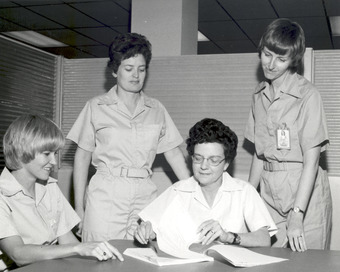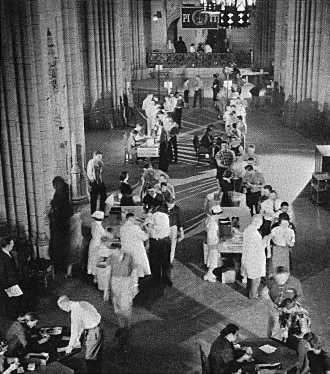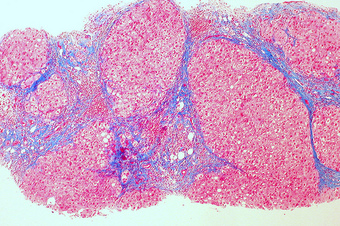2.2 Controlled Experiments
2.2: Controlled Experiments
2.2.1: The Salk Vaccine Field Trial
The Salk polio vaccine field trial incorporated a double blind placebo control methodology to determine the effectiveness of the vaccine.
Learning Objective
Key Takeaways
Key Points
- The first effective polio vaccine was developed in 1952 by Jonas Salk at the University of Pittsburgh.
- Roughly 440,000 people received one or more injections of the vaccine, about 210,000 children received a placebo, consisting of harmless culture media, and 1.2 million children received no vaccination and served as a control group, who would then be observed to see if any contracted polio.
- Two serious issues arose in the original experimental design: selection bias and diagnostic bias.
- The combination of randomized control and double-blind experimental factors, which were implemented in the second version of the experimental design, has become the gold standard for a clinical trial.
Key Terms
- control group
- the group of test subjects left untreated or unexposed to some procedure and then compared with treated subjects in order to validate the results of the test
- placebo
- an inactive substance or preparation used as a control in an experiment or test to determine the effectiveness of a medicinal drug
The Salk polio vaccine field trials constitute one of the most famous and one of the largest statistical studies ever conducted. The field trials are of particular value to students of statistics because two different experimental designs were used.
Background
The Salk vaccine, or inactivated poliovirus vaccine (IPV), is based on three wild, virulent reference strains:
- Mahoney (type 1 poliovirus),
- MEF-1 (type 2 poliovirus), and
- Saukett (type 3 poliovirus),
grown in a type of monkey kidney tissue culture (Vero cell line), which are then inactivated with formalin. The injected Salk vaccine confers IgG-mediated immunity in the bloodstream, which prevents polio infection from progressing to viremia and protects the motor neurons, thus eliminating the risk of bulbar polio and post-polio syndrome.
The 1954 Field Trial
Statistical tests of new medical treatments almost always have the same basic format. The responses of a treatment group of subjects who are given the treatment are compared to the responses of a control group of subjects who are not given the treatment. The treatment groups and control groups should be as similar as possible.
Beginning February 23, 1954, the vaccine was tested at Arsenal Elementary School and the Watson Home for Children in Pittsburgh, Pennsylvania. Salk’s vaccine was then used in a test called the Francis Field Trial, led by Thomas Francis; the largest medical experiment in history. The test began with some 4,000 children at Franklin Sherman Elementary School in McLean, Virginia, and would eventually involve 1.8 million children, in 44 states from Maine to California. By the conclusion of the study, roughly 440,000 received one or more injections of the vaccine, about 210,000 children received a placebo, consisting of harmless culture media, and 1.2 million children received no vaccination and served as a control group, who would then be observed to see if any contracted polio.
The results of the field trial were announced April 12, 1955 (the 10th anniversary of the death of President Franklin D. Roosevelt, whose paralysis was generally believed to have been caused by polio). The Salk vaccine had been 60–70% effective against PV1 (poliovirus type 1), over 90% effective against PV2 and PV3, and 94% effective against the development of bulbar polio. Soon after Salk’s vaccine was licensed in 1955, children’s vaccination campaigns were launched. In the U.S, following a mass immunization campaign promoted by the March of Dimes, the annual number of polio cases fell from 35,000 in 1953 to 5,600 by 1957. By 1961 only 161 cases were recorded in the United States.
Experimental Design Issues
The original design of the experiment called for second graders (with parental consent) to form the treatment group and first and third graders to form the control group. This design was known as the observed control experiment.
Two serious issues arose in this design: selection bias and diagnostic bias. Because only second graders with permission from their parents were administered the treatment, this treatment group became self-selecting.
Thus, a randomized control design was implemented to overcome these apparent deficiencies. The key distinguishing feature of the randomized control design is that study subjects, after assessment of eligibility and recruitment, but before the intervention to be studied begins, are randomly allocated to receive one or the other of the alternative treatments under study. Therefore, randomized control tends to negate all effects (such as confounding variables) except for the treatment effect.
This design also had the characteristic of being double-blind. Double-blind describes an especially stringent way of conducting an experiment on human test subjects which attempts to eliminate subjective, unrecognized biases carried by an experiment’s subjects and conductors. In a double-blind experiment, neither the participants nor the researchers know which participants belong to the control group, as opposed to the test group. Only after all data have been recorded (and in some cases, analyzed) do the researchers learn which participants were which.
This combination of randomized control and double-blind experimental factors has become the gold standard for a clinical trial.
2.2.2: The Portacaval Shunt
Numerous studies have been conducted to examine the value of the portacaval shunt procedure, many using randomized controls.
Learning Objective
Key Takeaways
Key Points
- A portacaval shunt is a treatment for the liver in which a connection is made between the portal vein, which supplies 75% of the liver’s blood, and the inferior vena cava, the vein that drains blood from the lower two-thirds of the body.
- Of the studies on portacaval shunts, 63% were conducted without controls, 29% were conducted with non-randomized controls, and 8% were conducted with randomized controls.
- The thinking behind random assignment is that any effect observed between treatment groups can be linked to the treatment effect and cannot be considered a characteristic of the individuals in the group.
- Because most basic statistical tests require the hypothesis of an independent randomly sampled population, random assignment is the desired assignment method.
Key Terms
- shunt
- a passage between body channels constructed surgically as a bypass
- random assignment
- an experimental technique for assigning subjects to different treatments (or no treatment)
A portacaval shunt is a treatment for high blood pressure in the liver. A connection is made between the portal vein, which supplies 75% of the liver’s blood, and the inferior vena cava, the vein that drains blood from the lower two-thirds of the body. The most common causes of liver disease resulting in portal hypertension are cirrhosis , caused by alcohol abuse, and viral hepatitis (hepatitis B and C). Less common causes include diseases such as hemochromatosis, primary biliary cirrhosis (PBC), and portal vein thrombosis. The procedure is long and hazardous .
Numerous studies have been conducted to examine the value of and potential concerns with the surgery. Of these studies, 63% were conducted without controls, 29% were conducted with non-randomized controls, and 8% were conducted with randomized controls.
Randomized Controlled Experiments
Random assignment, or random placement, is an experimental technique for assigning subjects to different treatments (or no treatment). The thinking behind random assignment is that by randomizing treatment assignments, the group attributes for the different treatments will be roughly equivalent; therefore, any effect observed between treatment groups can be linked to the treatment effect and cannot be considered a characteristic of the individuals in the group.
In experimental design, random assignment of participants in experiments or treatment and control groups help to ensure that any differences between and within the groups are not systematic at the outset of the experiment. Random assignment does not guarantee that the groups are “matched” or equivalent, only that any differences are due to chance.
The steps to random assignment include:
- Begin with a collection of subjects – for example, 20 people.
- Devise a method of randomization that is purely mechanical (e.g. flip a coin).
- Assign subjects with “heads” to one group, the control group; assign subjects with “tails” to the other group, the experimental group.
Because most basic statistical tests require the hypothesis of an independent randomly sampled population, random assignment is the desired assignment method. It provides control for all attributes of the members of the samples—in contrast to matching on only one or more variables—and provides the mathematical basis for estimating the likelihood of group equivalence for characteristics one is interested in. This applies both for pre-treatment checks on equivalence and the evaluation of post treatment results using inferential statistics. More advanced statistical modeling can be used to adapt the inference to the sampling method.
2.2.3: Statistical Controls
A scientific control is an observation designed to minimize the effects of variables other than the single independent variable.
Learning Objective
Classify scientific controls and identify how they are used in experiments.
Key Takeaways
Key Points
- Scientific controls increase the reliability of test results, often through a comparison between control measurements and the other measurements.
- Positive and negative controls, when both are successful, are usually sufficient to eliminate most potential confounding variables.
- Negative controls are groups where no phenomenon is expected. They ensure that there is no effect when there should be no effect.
- Positive controls are groups where a phenomenon is expected. That is, they ensure that there is an effect when there should be an effect.
Key Terms
- confounding variable
- an extraneous variable in a statistical model that correlates (positively or negatively) with both the dependent variable and the independent variable
- scientific control
- an experiment or observation designed to minimize the effects of variables other than the single independent variable
What Is a Control?
A scientific control is an observation designed to minimize the effects of variables other than the single independent variable. This increases the reliability of the results, often through a comparison between control measurements and the other measurements.
For example, during drug testing, scientists will try to control two groups to keep them as identical as possible, then allow one group to try the drug. Another example might be testing plant fertilizer by giving it to only half the plants in a garden: the plants that receive no fertilizer are the control group, because they establish the baseline level of growth that the fertilizer-treated plants will be compared against. Without a control group, the experiment cannot determine whether the fertilizer-treated plants grow more than they would have if untreated.
Ideally, all variables in an experiment will be controlled (accounted for by the control measurements) and none will be uncontrolled. In such an experiment, if all the controls work as expected, it is possible to conclude that the experiment is working as intended and that the results of the experiment are due to the effect of the variable being tested. That is, scientific controls allow an investigator to make a claim like “Two situations were identical until factor X occurred. Since factor X is the only difference between the two situations, the new outcome was caused by factor X. ”
Controlled Experiments
Controlled experiments can be performed when it is difficult to exactly control all the conditions in an experiment. In this case, the experiment begins by creating two or more sample groups that are probabilistically equivalent, which means that measurements of traits should be similar among the groups and that the groups should respond in the same manner if given the same treatment. This equivalency is determined by statistical methods that take into account the amount of variation between individuals and the number of individuals in each group. In fields such as microbiology and chemistry, where there is very little variation between individuals and the group size is easily in the millions, these statistical methods are often bypassed and simply splitting a solution into equal parts is assumed to produce identical sample groups.
Types of Controls
The simplest types of control are negative and positive controls. These two controls, when both are successful, are usually sufficient to eliminate most potential confounding variables. This means that the experiment produces a negative result when a negative result is expected and a positive result when a positive result is expected.
Negative Controls
Negative controls are groups where no phenomenon is expected. They ensure that there is no effect when there should be no effect. To continue with the example of drug testing, a negative control is a group that has not been administered the drug. We would say that the control group should show a negative or null effect.
If the treatment group and the negative control both produce a negative result, it can be inferred that the treatment had no effect. If the treatment group and the negative control both produce a positive result, it can be inferred that a confounding variable acted on the experiment, and the positive results are likely not due to the treatment.
Positive Controls
Positive controls are groups where a phenomenon is expected. That is, they ensure that there is an effect when there should be an effect. This is accomplished by using an experimental treatment that is already known to produce that effect and then comparing this to the treatment that is being investigated in the experiment.
Positive controls are often used to assess test validity. For example, to assess a new test’s ability to detect a disease, then we can compare it against a different test that is already known to work. The well-established test is the positive control, since we already know that the answer to the question (whether the test works) is yes.
For difficult or complicated experiments, the result from the positive control can also help in comparison to previous experimental results. For example, if the well-established disease test was determined to have the same effectiveness as found by previous experimenters, this indicates that the experiment is being performed in the same way that the previous experimenters did.
When possible, multiple positive controls may be used. For example, if there is more than one disease test that is known to be effective, more than one might be tested. Multiple positive controls also allow finer comparisons of the results (calibration or standardization) if the expected results from the positive controls have different sizes.

Controlled Experiments
An all-female crew of scientific experimenters began a five-day exercise on December 16, 1974. They conducted 11 selected experiments in materials science to determine their practical application for Spacelab missions and to identify integration and operational problems that might occur on actual missions. Air circulation, temperature, humidity and other factors were carefully controlled.
Attributions
- The Salk Vaccine Field Trial
-
“PittPolioVaccineCoL.”
http://commons.wikimedia.org/wiki/File:PittPolioVaccineCoL.jpg.
Wikimedia
Public domain.
- The Portacaval Shunt
-
“Cirrhosis of the liver (trichrome stain) | Flickr – Photo Sharing!.”
http://www.flickr.com/photos/euthman/5690946257/.
Flickr
CC BY.
- Statistical Controls
-
“confounding variable.”
http://en.wiktionary.org/wiki/confounding_variable.
Wiktionary
CC BY-SA 3.0. -
“Materials Science Experiments Conducted at MSFC – GPN-2002-000198.”
http://commons.wikimedia.org/wiki/File:Materials_Science_Experiments_Conducted_at_MSFC_-_GPN-2002-000198.jpg.
Wikimedia
Public domain.



